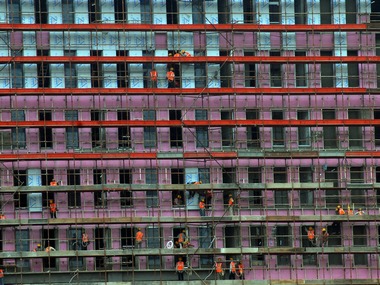Goldman Sachs’ (GS) report on the real estate sector could not have come at a more inopportune moment. The broking firm has come out with a buy report on a day when the sector indices have fallen by over 4 percent. Goldman’s argument is the current pricing and demand environment is much better than what it was in 2009. The report is positive that even if the companies are trading at lower valuations - similar to those in 2008 - these have better balance sheets and are confident of weathering the US storm, as evidenced by the absorption and mortgage data.
[caption id=“attachment_70442” align=“alignleft” width=“380” caption=“Higher commodity prices of both steel and cement, slower approvals and high inventory in commercial real estate have already complicated the scene. Reuters”]  [/caption]
The broking firm has come out with a separate report on DLF where it has upgraded the company from a ‘Neutral’ to ‘Buy’. The stock has corrected by 32 percent, against a Sensex fall of 20 percent. The stock is trading at its historic trough valuation at 1.1 times its price to book value for financial year 2012 numbers. DLF’s stock price is valuing its land price and rental assets at 157 million square feet compared to its land bank of 360 million square feet.
Goldman Sachs picks DLF, Sobha, HDIL and Oberoi as its buy ones while it has put out a sell on Godrej Properties and Phoenix Mills. The broking firm has a target of Rs 254 for DLF against its current price of Rs 178, a potential upside of 40 percent. Oberoi also offers an upside of over 40 percent with a price target of Rs 309 as against the current price of Rs 216.5.
Impact Shorts
More ShortsAmong the stocks covered by Goldman Sachs, HDIL offers a higher percentage return of nearly 70 percent, with a target of Rs 164 against the current price of Rs 97. Sobha has a price target of Rs 340 compared to the current price Rs 209, a potential gain of over 60 percent.
Though the report has a buy call on some of the stocks, it has adjusted the profit figures downwards by 7 percent for the current fiscal on account of slower project execution. It does mention that the real estate sector is being plagued by interest rates moving up by over 3 percent over the past six quarters, thus making borrowing dearer and lowering end-user affordability. Higher commodity prices of both steel and cement, slower approvals and high inventory in commercial real estate have already complicated the scene.


)

)
)
)
)
)
)
)
)



